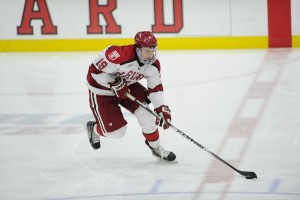Brandon Pirri is the latest forward to sign with the New York Rangers this offseason and the talk on social media seems to revolve around the sudden abundance at the position. Going into the summer, the talk around the Rangers suggested that they had an interest in retooling the team. Most concerns stemmed from the defense, as the team had seen a great strength deteriorate into a weakness. This fact has raised the question of why the team is doing so much to their forward core, without adding much on the other end of the rink.

Nothing Is Easy
The assumption coming into the 2016-2017 campaign is that both Pavel Buchnevich and Jimmy Vesey will have guaranteed roster spots despite the fact that neither has played a game in the NHL yet. While both have the talent and potential to be full-time NHLers, it’s hard to surrender the entire third line without even a fight to two prospects and a center coming off a bad season (Kevin Hayes). Grabbing players like Josh Jooris and Maxim Lapierre isn’t going to make the wingers think twice about their role on the team, but adding solid skilled players like Pirri and Michael Grabner may push them a bit.
Having healthy competition on the roster is key to pushing a team to the next level, and considering we’re talking about two forwards who will likely be the spine of the Rangers’ future, it’s imperative that they hit the ground running and not get complacent.
The Defense Did Change
Hearing people talk about the team might lead one to believe that New York just left the defense as is and acquired a glut of forwards, but the truth is that the defense will look very different this year. The team has moved on from both Dan Boyle and Keith Yandle, who played 74 and 82 games respectively. It’s no surprise that the team moved on from Boyle, the season was a struggle for him, but to lose Yandle is tough as the American rear-guard had 47 points from the back-end. The fact is that this is life in the NHL during the salary-cap era; teams will lose talent.
Both Brady Skjei and Dylan McIlrath are expected to step right into the now vacant positions, which makes sense from an organization standpoint as the players are 22- and 24-years-old respectively and both seemed to take steps forward last year. For depth and perhaps competition, the team also went out and got cost-effective talent in players like Nick Holden and Adam Clendening. No, they aren’t superstars or even big names. However, they are good skaters who have NHL experience to support what will be a younger defense core this season if they don’t flat out win an opening night spot on the roster.
Depth Is a Good Problem
Going into the season, teams need options. When you have different roads to take, you allow coach Alain Vigneault to get creative with the roster and general manager Jeff Gorton gives himself a play if he decides to make a move of some kind.
One common denominator of all the moves made by New York is that every signed player was a value deal. They didn’t dip into the market to overpay a veteran with the hope of him carrying the team. Instead, they went out and shopped for younger guys on the cusp of the NHL to try to supplement the fact that they’ve traded away a boatload of assets to make their runs in past seasons.
My Take
Maybe the Rangers are still looking to move a guy like Rick Nash, or maybe they just thought they’d take a few low-risk chances. Whatever their mindset, I have to say that I agree with their approach. I’m positive that one of these guys will jump off the page in camp to claim a surprise spot on the team, simply because there’s too much young and hungry talent. Guys who aren’t great may end up on waivers or perhaps in Hartford, where they could help the next batch of Rangers play a better brand of hockey.
I suspect that the defense will be better this year as there will be fewer cooks in the kitchen and I think the Rangers will get back to the speed game because almost all of their moves worked towards getting faster. In today’s NHL, speed kills.